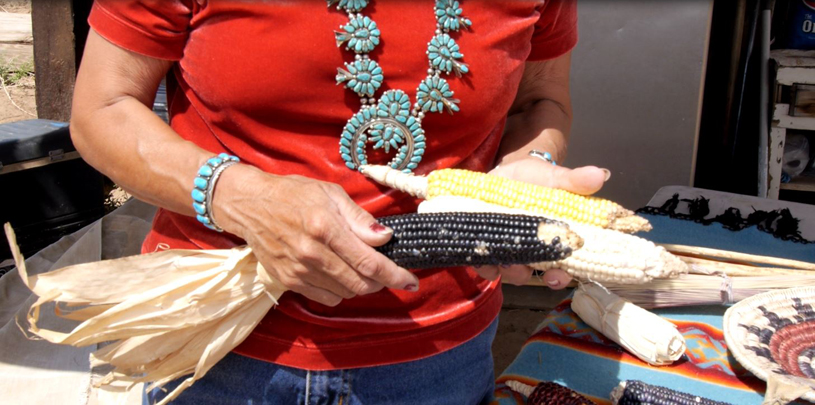
 by Stacie Tsingine, Native American Intertribal Gathering Associate
by Stacie Tsingine, Native American Intertribal Gathering Associate
While genetically modified corn and soybeans reign supreme on most American farms, generations-old heirloom crops grow in fields across the Navajo reservation. Diné farmer Effie James’ garden in Moenave, Arizona, teems with diversity. Apricot trees, grape vines, and tomatoes grow alongside a medley of vegetables, all grown from seeds she has saved over the years.
They sit on a shelf in glass jars, labeled not by variety but by the name of the farmer from whom she got the seeds.
A few years back, Effie went to the Painted Desert Farmer’s Market in search of the most delicious melon she could find. She bought one from renowned master farmer Rose Marie Williams, whose family has farmed in Kerley Valley for generations. She cut the melon in half, scooped out the seeds, rinsed them off, and left them to dry, enjoying the sweet, juicy flesh as a bonus.
Now, each spring, she pulls out her jar labeled “Rose Marie’s Melons” to plant her own crop of the delicious fruit.
Heirloom crops, like Rose Marie’s Melons, are not used in modern industrial agriculture. Instead, genetically modified seeds account for over 90 percent of the corn, soybeans, and cotton produced in the United States. These engineered seeds produce high yields, but they also require expensive fertilizers and toxic pesticides.
As farmers convert to planting genetically modified organisms (GMOs), food varieties go extinct. The Food and Agriculture Organization estimates that 90 percent of fruit and vegetable varieties have vanished.
But on the Navajo reservation, farmers are using their traditional ecological knowledge to save heirloom seeds.
Saving seeds is a time-honored tradition of Navajo farmers that mimics nature. If left unharvested, ripe fruit falls to the ground and decomposes, leaving its seeds behind to sprout the following spring.
In July, the Intertribal Learning Center in Tuba City, Arizona hosted a Seed Sources Workshop to help local farmers turn last year’s bounty into next year’s harvest.
According to Alicia Tsosie, Food Corps Service Member and Trust partner, you want to dry the seeds, store them in a container or plastic bag, and label them with the year and name. The farmers chimed in with their tips:
“Whatever you do, don’t save summer squash seeds when they are mature,” Sam, who wore a straw hat even indoors, said. “You want to make sure you pick summer squash when it’s young, because that’s when it’s tender.”
Winter varieties, like acorn squash, can be a bit trickier. Sam warned that the seed is no good if you squeeze it and air comes out.
Seeds have different expiration dates, depending on the crop. For example, the kernels on a corncob are good for 10 years, while beans last for three.
Carrot seeds, on the other hand, remain viable for 2 years, the same length of time it takes to actually harvest the seed. Carrots grow their tasty root and green top in the first year, but they don’t flower until the following season, when the seed heads can be harvested.
We’ll be hosting more workshops this year at the Learning Center, which has a wealth of information to share with local farmers and community members. Exhibits showcase efforts by elders and community leaders from 12 tribes across the Colorado Plateau to preserve dry farming practices that have allowed native peoples to flourish for thousands of years. Join us next time for more farming tips!
A small victory in the legal case challenging Daneros uranium mine, near Bears Ears National Monument.
Read MoreMugs, handmade soaps, high fashion, jewelry and more. There's something for everyone on your holiday shopping list.
Read MoreBears Ears petroglyph panels and cultural sites protected by new proposed management plan.
Read More